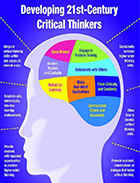Connectivism Theory in Learning
Connectivism Theory in Learning
 Connectivism is a theory of learning that emphasises on the role of internet in creating new opportunities for people to learn and share information across the web and among themselves. Some of the technologies under connectivism include web browsers, email, social networks, online forums, etc.
Connectivism is a theory of learning that emphasises on the role of internet in creating new opportunities for people to learn and share information across the web and among themselves. Some of the technologies under connectivism include web browsers, email, social networks, online forums, etc. This theory was developed by George Siemens and Stephen Downes, who proposed connectivism as a learning theory for the digital age, and as a successor to behaviourism, cognitivism and constructivism.
An important aspect of connectivism is, most of the learning takes place across peer networks. A teacher guides the students to information and helps them answer questions. Under this form of learning, students are often encouraged to seek out information on their own and share what they find.
Concepts like MOOC (Massive Open Online Course) have been developed based on connectivism. A MOOC is a platform that makes use of an open software and system across the web. It is open to anyone who wants to enrol. While the course facilitators merely provide guidance, the participants are responsible for what they learn and how they share it.
The principles of connectivism are as follows:
-
Learning and knowledge rests in diversity of opinions
Connectivism states that learning takes place due to the difference in opinions of the learners.
-
Learning is a process of connecting information sources
According to the theory, learning brings together the different sources of information.
-
Learning may reside in non-human appliances
Learning is not restricted to human interaction. It can occur even through non-human interaction.
-
Capacity to know more is more critical than what is currently known
The ability to learn is quite large and there is always a scope to learn more than what one already knows.
-
Nurturing and maintaining connections are needed to facilitate continual learning
Peer to peer interaction and human networking play a key role in facilitating learning.
-
Ability to see connections between fields, ideas and concept is a core skill
Connectivism helps one to understand the different areas, ideas and concepts where learning can occur.
-
Decision making is itself a learning process
Connectivism believes decision making to be a learning process.
Advantages:
 Connectivism offers many advantages like:
Connectivism offers many advantages like: -
Student/learner driven
Connectivism is driven by the learner, which means, the learner can learn whatever he/she wants, at a pace that suits him/her.
-
Focuses on the needs of the students belonging to the current generation
This theory caters to the needs of the students belonging to the current generation and hence, is regarded as the theory of 21st century.
-
Connects the learner to the learning community
Under connectivism, the learner is closely connected to the learning community. This peer to peer interaction makes knowledge acquisition smoother. It also helps the learner to expand his knowledge on a given subject.
-
Learner connects different pieces of data
Connectivism supports a continuous learning process and when the learner learns on a regular basis, he/she is able to relate different pieces of information and develop his/her understanding of a topic.
-
Fosters creativity and collaboration
Connectivism typically focuses on the idea that a learner learns best when he/she is connected to the people and the learning process. This also encourages students to think outside the box and form a network of learners.
Disadvantages:
Despite being a learning theory well-suited for the modern world, connectivism is often looked down upon for the following reason:
-
 Students learn according to their ability-level and not their age
Students learn according to their ability-level and not their age
The learners are not classified according to their age, but on the basis of their ability to learn. While this sounds like a novel way to approach learning, slow-learners often tend to get left behind.
-
Students may be labelled and grouped
Connectivism in learning may lead to the students being grouped and labelled. This may impact their performance and may end up making them lose their confidence. -
Students may develop anxiety
Students tend to get grouped on the basis of their performance. This may affect the low-performers and they may end up developing anxiety issues.
-
The role of educators is unclear
While connectivism is all about learners, the role of the educator is restricted to that of a mere facilitator. Thus, the educators’ role becomes unclear.
-
The theory is still being developed
Connectivism as a theory is still in the developmental phase where its possibilities are still being explored.
In a nutshell, with the world moving towards a technology-enabled learning, connectivism appears to be an effective tool to enhance learning and provide a platform for the learners to interact.





















